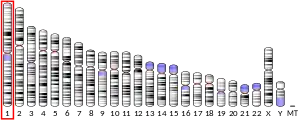HIST2H3A
Histone cluster 2 H3 family member a is a protein that in humans is encoded by the HIST2H3A gene. [4]
Function
Histones are basic nuclear proteins that are responsible for the nucleosome structure of the chromosomal fiber in eukaryotes. This structure consists of approximately 146 bp of DNA wrapped around a nucleosome, an octamer composed of pairs of each of the four core histones (H2A, H2B, H3, and H4). The chromatin fiber is further compacted through the interaction of a linker histone, H1, with the DNA between the nucleosomes to form higher order chromatin structures. This gene is intronless and encodes a replication-dependent histone that is a member of the histone H3 family. Transcripts from this gene lack polyA tails; instead, they contain a palindromic termination element. This gene is found in a histone cluster on human chromosome 1. This gene is one of four histone genes in the cluster that are duplicated; this record represents the centromeric copy. [provided by RefSeq, Aug 2015].
References
- GRCh38: Ensembl release 89: ENSG00000203852 - Ensembl, May 2017
- "Human PubMed Reference:". National Center for Biotechnology Information, U.S. National Library of Medicine.
- "Mouse PubMed Reference:". National Center for Biotechnology Information, U.S. National Library of Medicine.
- "Entrez Gene: Histone cluster 2 H3 family member a". Retrieved 2018-08-05.
Further reading
- Ruthenburg AJ, Wang W, Graybosch DM, Li H, Allis CD, Patel DJ, Verdine GL (August 2006). "Histone H3 recognition and presentation by the WDR5 module of the MLL1 complex". Nat. Struct. Mol. Biol. 13 (8): 704–12. doi:10.1038/nsmb1119. PMC 4698793. PMID 16829959.
- Couture JF, Collazo E, Trievel RC (August 2006). "Molecular recognition of histone H3 by the WD40 protein WDR5". Nat. Struct. Mol. Biol. 13 (8): 698–703. doi:10.1038/nsmb1116. PMID 16829960. S2CID 26165068.
- Rodriguez-Collazo P, Snyder SK, Chiffer RC, Zlatanova J, Leuba SH, Smith CL (January 2008). "cAMP signaling induces rapid loss of histone H3 phosphorylation in mammary adenocarcinoma-derived cell lines". Exp. Cell Res. 314 (1): 1–10. doi:10.1016/j.yexcr.2007.09.011. PMC 4426871. PMID 17950276.
- Ho CC, Cheng CC, Liu YH, Pei RJ, Hsu YH, Yeh KT, Ho LC, Tsai MC, Lai YS (2008). "Possible relation between histone 3 and cytokeratin 18 in human hepatocellular carcinoma". In Vivo. 22 (4): 457–62. PMID 18712172.
- Song JJ, Kingston RE (December 2008). "WDR5 interacts with mixed lineage leukemia (MLL) protein via the histone H3-binding pocket". J. Biol. Chem. 283 (50): 35258–64. doi:10.1074/jbc.M806900200. PMC 2596411. PMID 18840606.
- Xie W, Song C, Young NL, Sperling AS, Xu F, Sridharan R, Conway AE, Garcia BA, Plath K, Clark AT, Grunstein M (February 2009). "Histone h3 lysine 56 acetylation is linked to the core transcriptional network in human embryonic stem cells". Mol. Cell. 33 (4): 417–27. doi:10.1016/j.molcel.2009.02.004. PMC 2671231. PMID 19250903.
- Loomis RJ, Naoe Y, Parker JB, Savic V, Bozovsky MR, Macfarlan T, Manley JL, Chakravarti D (February 2009). "Chromatin binding of SRp20 and ASF/SF2 and dissociation from mitotic chromosomes is modulated by histone H3 serine 10 phosphorylation". Mol. Cell. 33 (4): 450–61. doi:10.1016/j.molcel.2009.02.003. PMC 2667802. PMID 19250906.
- Suphioglu C, Sadli N, Coonan D, Kumar L, De Mel D, Lesheim J, Sinclair AJ, Ackland L (February 2010). "Zinc and DHA have opposing effects on the expression levels of histones H3 and H4 in human neuronal cells". Br. J. Nutr. 103 (3): 344–51. doi:10.1017/S0007114509991826. PMID 19747413.
This article incorporates text from the United States National Library of Medicine, which is in the public domain.

